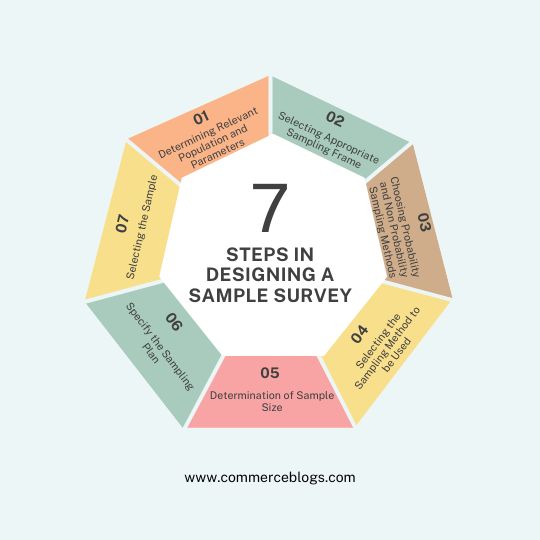Introduction to How to Design a Sample Survey
In this article we will go through the topic How to Design a Sample Survey. A sample survey is a research method used to collect data from a subset or sample of a larger population. Instead of surveying every individual in the population, researchers select a representative sample and gather information from them. This approach is often more feasible and cost-effective than trying to survey an entire population.
Steps to Design a Sample Survey
Step 1. Determining Relevant Population and Parameters
The initial step in any sampling procedure is the determination of appropriate population and parameters being used to identify sampling units. For example, if we have to conduct a survey on consumption of tea in Rajasthan up to December 2023, then the specifications might be as follows:
1. Elements: House wives
2. Sampling units: Households, then housewives
3. Extent: Rajasthan State
4. Term: Up to December, 2023
It should be clear that all the above four specifications must be contained in the selected population.
Step 2. Selecting Appropriate Sampling Frame
Selection of appropriate sampling frame implies the identification of the members of total population. An ideal sampling frame is a complete listing of all the members of the population. But complete listing of all the population is practically impossible. As such, the researcher is required to decide about the sampling frame and then select the sample units from the frame.
Step 3. Choosing between Probability and Non probability Sampling methods
It indicates how the sample units are selected one of the most important decisions in this regard is to determine which of the two-probability and non-probability sampling methods to be selected. Probability sampling enables the researcher to choose representative sample design. It also enables the researcher the extent to which the results based on such a sample are likely to be different from what would have been obtained if covered the entire population. Non probability sampling does not yield these benefits. It is often preferred to probability sampling because of convenience and economy.
Step 4. Selecting the sampling method to be used
There are various types of sample designs which can be covered under the two groups viz. probability and non-probability sampling.
The probability sampling includes the following method
(a) Simple random sampling
(b) Systematic random sampling
(c) Stratified random sampling
(d) Cluster Sampling
(e) Area Sampling
(f) Multi-stage Sampling
(g) Multi-phase sampling
The non probability sampling includes the following methods
(a) Convenience sampling
(b) Purposive sampling
(c) Quota sampling
(d) Judgement sampling
(e) Snowball Sampling.
Out of the above methods researcher is required to select one suitable method. The choice of the method depends upon the nature of the problem, size of the universe, sample size, availability of time and resources, accuracy of results desired etc.
Step 5. Determination of Sample Size
In order that the study should be meaningful and logical, the researcher has to decide about the size of the sample, i.e. how many elements of the target population are to be chosen.
There are two major approaches to the determination of sample size necessary for a given level of accuracy viz. Traditional and Bayesian. In traditional method the determination of sample size depends on the method of sampling employed. Whereas in Bayesian approach determination of sample size is concerned with cost-versus-value aspect of alternate sample sizes.
Factors affecting the Size of Sample
The optimum size of a sample is determined not only by any one factor but by several factors as described below
(i) Nature of the universe
If the units of a universe are homogeneous, a small size of sample will be sufficient, but if the units are of varied nature, a large size of sample will be necessary.
(ii) Number of groups
If the collected data are classified in a greater number of groups the size of sample will have to be larger, because if a small sample is taken some of the groups would contain one or two items only, so the problem would not be solved with desired accuracy.
(iii) Nature of the investigation
If deep and intensive study is desired than size of sample will have to be kept small, because for the study of larger samples, more resources are required. For ordinary surveys large samples are needed and for technical survey a small sample is needed.
(iv) Degree of accuracy
It has been explained earlier that larger the size of sample, higher will be the degree of accuracy. But it is not so in all the cases. If the sample is collected by the experts using scientific methods a small sample can also give very accurate results.
(v) Sampling method
The method of sampling also affects the size of sample. Generally, if simple random sampling method is used size of sample will be kept large but in case stratified sampling method is used a small size of sample will give very accurate results.
(vi) Nature of Informants
If information is expected only from a smaller number of informants size of sample shall be kept large.
(vii) Size of questionnaire
If size of questionnaire and number of questions asked are large, size of the sample has to be kept small.
(viii) Practical factors
Money, time and number of trained enumerators available affect the size of the sample. If these resources are available in enough quantity, size of the sample can be taken large.
Step 6. Specify the Sampling plan
This means that researcher should indicate that how the decisions made so far are to be implemented. For example, if a survey of households is to be conducted, a sampling plan should define a household, certain instruction to the interviewer as to how he should take a systematic sample of households, advise him on what he should do when no one is available on his visit to the household and so on.
Step 7. Selecting the Sample
The next and final step in the process is to select the sample and gather information from such sample units. After the sample units are selected, the researcher can start collecting data using available techniques like observation, questionnaire or schedule and interviews.
Read Also : Primary and Secondary Data


Magnificent beat I would like to apprentice while you amend your site how can i subscribe for a blog web site The account helped me a acceptable deal I had been a little bit acquainted of this your broadcast offered bright clear idea
Thanks I have recently been looking for info about this subject for a while and yours is the greatest I have discovered so far However what in regards to the bottom line Are you certain in regards to the supply
I have read some excellent stuff here Definitely value bookmarking for revisiting I wonder how much effort you put to make the sort of excellent informative website
Wow wonderful blog layout How long have you been blogging for you make blogging look easy The overall look of your site is great as well as the content
For the reason that the admin of this site is working, no uncertainty very quickly it will be renowned, due to its quality contents.
Great information shared.. really enjoyed reading this post thank you author for sharing this post .. appreciated
Nice post. I learn something totally new and challenging on websites
Good post! We will be linking to this particularly great post on our site. Keep up the great writing